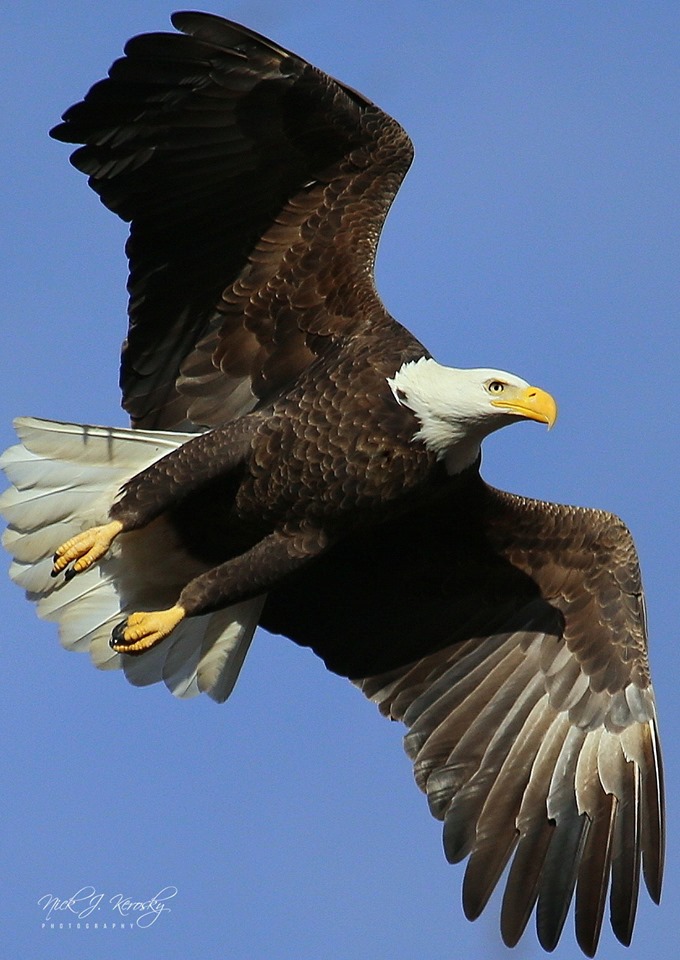
COLUMBUS, April 22 – The Ohio Department of Natural Resources Division of Wildlife is reporting 706 bald eagle nests in Ohio, following a comprehensive census in February and March.
The findings reflect thousands of reports from “citizen scientists.” The last state census was conducted eight years ago. The results show an increase of 151 percent from 2012, when 281 nests were recorded.
Trumbull County reported 26 bald eagle nests for 2020, the fourth highest number in the state. In 2012, the county reported nine nests.
“We are grateful to every Ohioan who contributed to this effort and thank those who support conservation of high-quality habitat that kept eagles nesting in Ohio,” said Kendra Wecker, head of the Division of Wildlife.
The Division of Wildlife received approximately 2,500 reports from the public for the 2020 census. Wildlife staff, including wildlife officers and biologists, verified nest locations in 85 counties.
Counties along or near Lake Erie have the highest number of bald eagle nests. Bald eagles thrive near Lake Erie because of the abundance of food and nesting habitat. The 12 counties with the highest number of eagle nests include: Ottawa (90), Sandusky (50), Erie (32), Trumbull (26), Seneca (24), Wyandot (19), Lucas (18), Licking (17), Ashtabula (16), Knox (16), Mercer (16) and Wood (16).
The bald eagle was once an endangered species, with only four nesting pairs in Ohio in 1979. However, due to partnerships between the Division of Wildlife, zoos, wildlife rehabilitation facilities, concerned landowners, and sportsmen and women, its population increased. The bald eagle was removed from the federal list of threatened and endangered species in 2007 and from Ohio’s list in 2012.
Locally, bald eagle viewing opportunities include the Mosquito Creek Wildlife Area in Trumbull County. Other locations can be found at Magee Marsh Wildlife Area (Lucas and Ottawa counties), Pickerel Creek Wildlife Area (Sandusky County), Ottawa National Wildlife Refuge (Lucas and Ottawa counties), and Killdeer Plains Wildlife Area (Wyandot and Marion counties). In southern Ohio, eagle nests are found near major rivers such as the Muskingum, Hocking, Scioto and Great Miami.
Nick Kerosky, a Cortland-based wildlife photographer, captured this bald eagle last October at Mosquito Creek Lake in Mosquito Lake State Park. (Image by Nick Kerosky and courtesy of Trumbull County Tourism)Bald eagles in Ohio typically lay eggs and incubate in February and March. Young eagles leave the nest about three months later, usually in June. The birds nest in large trees such as sycamores, oaks, and cottonwoods near large bodies of water. Fish and carrion are preferred foods.
Bald eagles are protected under state law and the federal Bald and Golden Eagle Protection Act. It is illegal to disturb bald eagles. When viewing these birds, remember to respect the bird’s space and stay at least 100 yards away from a bird or nest. Disturbing bald eagles at the nest site could lead the pair to abandon the eggs.
As with many of Ohio’s native wildlife species, bald eagles require specific habitat conditions to thrive. Bald eagle habitat protection and research is funded by the sale of bald eagle conservation license plates, income tax check-off donations to the Endangered Species and Wildlife Diversity Fund and sales of the Ohio Wildlife Legacy Stamp. Learn how to support Ohio wildlife at wildohio.gov…
The mission of the Division of Wildlife is to conserve and improve fish and wildlife resources and their habitats for sustainable use and appreciation. Visit wildohio.gov… to learn more. Visit the ODNR website at ohiodnr.gov….
By County: Verified Bald Eagle Nests in Ohio
Verified active bald eagle nests in 2020 are shown below. The first number following the county’s name shows the number of nests for 2020, with the 2012 number in parentheses. These numbers are raw data and subject to change.
Statewide nest totals for 2020: 707; 2012 totals: (281).
Adams: 1 (0); Allen: 5 (0); Ashland: 9 (2); Ashtabula: 16 (9); Athens: 1 (0); Auglaize: 4 (0); Belmont: 4 (1); Brown: 4 (1); Butler: 8 (0); Carroll: 1 (0); Champaign: 2 (0); Clark: 5 (0); Clermont: 4 (0); Clinton: 2 (0); Columbiana: 4 (1); Coshocton: 14 (6); Crawford: 6 (3); Cuyahoga: 3 (2); Darke: 1 (0); Defiance: 8 (2); Delaware: 13 (7); Erie: 32 (17); Fairfield: 2 (0); Fayette: 3 (0); Franklin: 5 (3); Fulton: 3 (0); Gallia: 1 (0); Geauga: 7 (6); Greene: 4 (0); Guernsey: 2 (1); Hamilton: 3 (1); Hancock: 12 (4); Hardin: 9 (1); Harrison: 1 (1); Henry: 6 (0); Highland: 4 (1); Hocking: 1 (1); Holmes: 5 (1); Huron: 15 (5) Jackson: 0 (0); Jefferson: 2 (1); Knox: 16 (7); Lake: 7 (4); Lawrence: 0 (0); Licking: 17 (3); Logan: 8 (1); Lorain: 10 (3); Lucas: 18 (8); Madison: 2 (0); Mahoning: 7 (5); Marion: 11 (6); Medina: 5 (1); Meigs: 0 (0); Mercer: 16 (3); Miami: 5 (0); Monroe: 4 (1); Montgomery: 3 (1); Morgan: 1 (1); Morrow: 5 (2); Muskingum: 6 (2); Noble: 1 (1); Ottawa: 90 (46); Paulding: 3 (0); Perry: 2 (0); Pickaway: 9 (3); Pike: 4 (2); Portage: 8 (5); Preble: 3 (0); Putnam: 8 (2); Richland: 14 (5); Ross: 7 (4); Sandusky: 50 (33); Scioto: 2 (2); Seneca: 24 (7); Shelby: 3 (0); Stark: 4 (1); Summit: 5 (2); Trumbull: 26 (9); Tuscarawas: 9 (6); Union: 8 (4); Van Wert: 2 (0); Vinton: 1 (0); Warren: 4 (2); Washington: 1 (1); Wayne: 7 (2); Williams: 4 (0); Wood: 16 (7); Wyandot: 19 (12).
Source: Ohio Department of Natural Resources
© 2020 Metro Monthly. All rights reserved.




